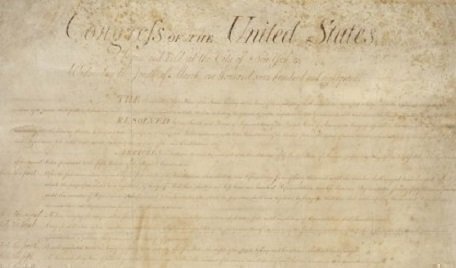On September 25, 1789, the First Congress made a highly-anticipated move in arguably the most important congressional session in history, when it agreed on a list of constitutional amendments known as the Bill of Rights.

The first session of the First Congress lasted 210 days. Much talk at that session since early June was about a proposal made by James Madison in the House about adding by amendment a list of individual rights to the Constitution agreed to in Philadelphia about two years earlier.
During three months of debate, Congress would finally settle on a final list of rights to present to the states. Some amendments on Madison’s initial list didn’t make the final cut in September. The House first agreed on a version of the Bill of Rights that had 17 amendments, and later, the Senate consolidated the list to 12 amendments.
Madison was then part of a conference committee that reconciled the differences between the two proposals. The committee’s version of the Bill of Rights mostly followed the Senate version, and the compromise had been passed by two-thirds of the House as required.
On September 25, the Senate met to consider other matters of business, including the permanent seat of the federal government. (At the time, Congress was meeting in New York City.) The House’s clerk sent a message to the Senate to announce that “the House of Representatives had passed a resolve, requesting ‘The President of the United States, to transmit to the executives of the several states, which have ratified the constitution, copies of the amendments proposed. by Congress to be added thereto; and like copies to the executives of the states of Rhode Island and North Carolina’ and that the House requested the concurrence of the Senate therein.’”
The Senate then concurred with the House’s proposal, starting the Bill of Rights’ ratification process.
The document sent to the states made it clear that the Bill of Rights addressed concerns voiced by the Anti-Federalists and others at the constitutional convention and the constitutional ratification process. “The conventions of a number of the states having, at the time of their adopting the constitution, expressed a desire, in order to prevent misconstruction or abuse of its powers, that further declaratory and restrictive clauses should be added; and as extending the ground of public confidence in the government will best insure the beneficent ends of its institution,” the communication read.
In the end, the states approved 10 of the 12 amendments by December 1791. One of first two amendments rejected by the states was eventually ratified in 1992 as the 27th Amendment; it restricted the ability of Congress to change the pay of a sitting Congress while in session. (The other proposed amendment dealt with the number of representatives in Congress, based on the 1789 population.) The third amendment proposed is today's First Amendment with the remainder following in the same order.







